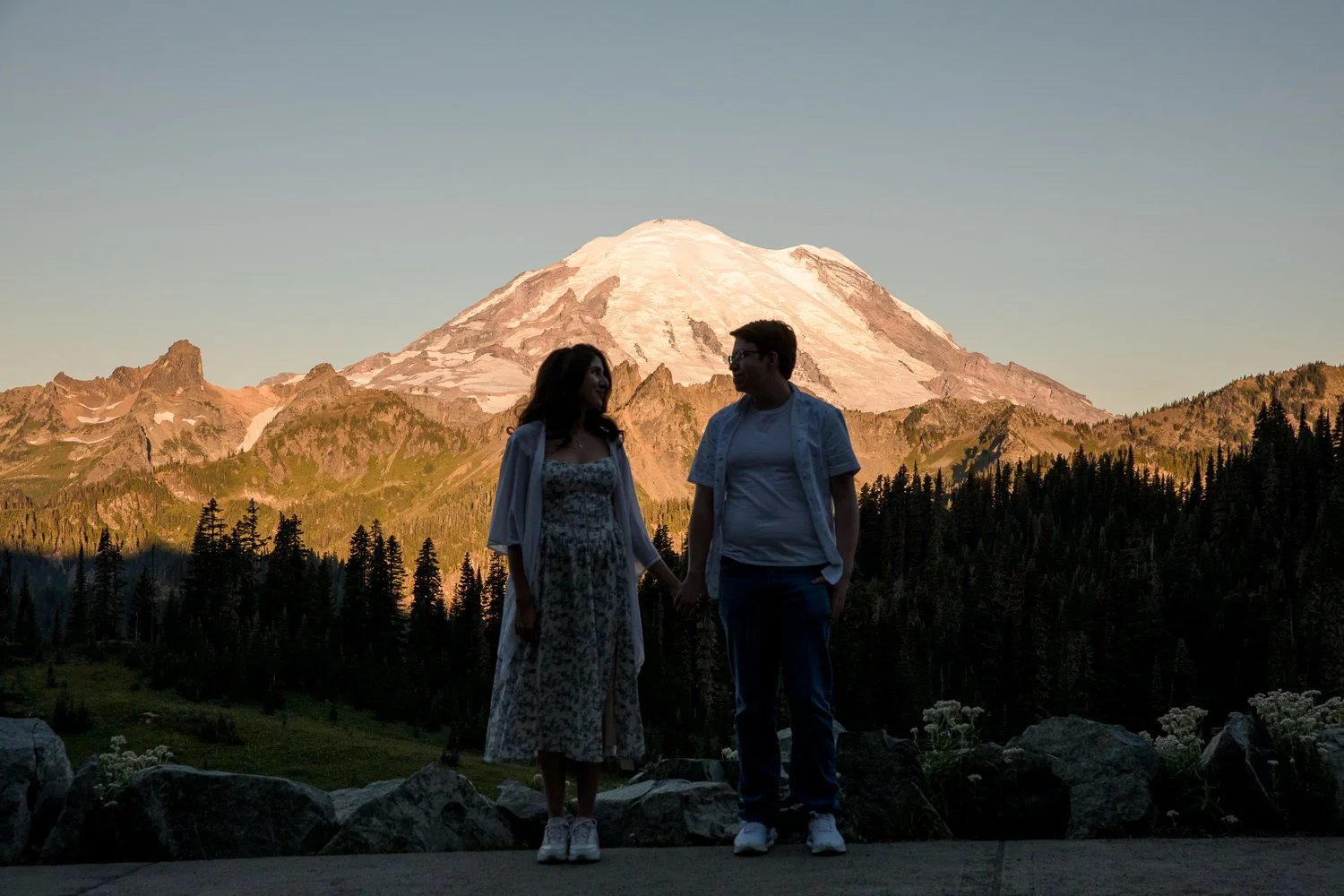Top 21 Places to Elope on the West Coast
You’ve narrowed your elopement destination to the west coast! It’s a beautiful place to explore, but what should you take into consideration before committing to a location?
Scenery
There are so many beautiful places to choose from that it’s easy to get distracted or overwhelmed. Before looking further, I’d suggest writing down the types of scenery and views that mean the most to you so you can keep that top of mind while sifting through all the tempting ideas below. Think of places that inspire you and the places that make you feel the happiest.
Seasonality
Do you already have a date set, time of year in mind, or are you hoping for certain weather? Some of the locations suggested below are similar year-round, while many of them vary depending on the season. The weather will determine what activities you can do, what you can wear, and how comfortable you’ll be, so be honest with yourself about what kind of weather you’d enjoy.
Experiences
Speaking of activities, this is the time to check off those bucket list experiences! What have you dreamed of doing or enjoy filling your time with? Some activities are seasonal, so a little bit of research in this department goes a long way.
Accessibility
Ask yourself how far you’re willing to travel. Some of the suggestions below are an hour or less away from international airports while others require a bit of driving, ferrying, boating, hiking, or flying seaplanes or helicopters to reach. How remote or accessible do you want your elopement location to be?
Popularity
Wherever you elope, you’ll want it to be secluded. Of course, the more accessible a place is, the more popular it is. If you’re willing to travel a bit further, it can go a long way to providing some privacy. If that doesn’t work well for you, consider eloping during the off or shoulder season to avoid the peak crowds of the high season. Plan on eloping on a weekday rather than the weekend and at sunrise or sunset, if possible, to avoid the most crowds.
Guests
If you plan on inviting guests, they’ll have their own needs and preferences as well. Consider how far they’d be willing to travel, and if they have any accessibility or health needs to consider when choosing a location.
The number of guests you bring with you will impact the number of options you’ll have for a ceremony location, but that doesn’t mean you won’t be able to elope somewhere just as stunning if it were just the two of you.
Of course, there are many ways to include guests without sacrificing your ideal location, activities, and intimacy. You can always do a private vow reading, schedule some intentional time away from everyone after your ceremony, or even celebrate separately the next day.
Washington
North Cascades National Park
Known as the “American Alps”, the North Cascades is two hours north of Seattle and gives you tremendous views of jagged mountains for as little or as much effort as you’d like to give. Simply driving through the park is stunning, but hike, snowshoe, or camp for extra views. Visit anytime between July and October.
Mount Rainier National Park
When Washingtonians exclaim “The mountain is out!”, Mount Rainier is what they’re referring to. Two hours south of Seattle and visible from all around the state, it’s easy to fall in love with her at first sight.
I tend to favor July through September on the mountain with wildflowers (peaking during August), clear views, and your pick of the hiking trails, although winter snowshoes in the park are quiet, blissful, and magical in their own way.
See a Mount Rainier elopement here.
Olympic National Park
Just one ferry ride from Seattle and you can leave all the crowds behind. This is the best area to “view it all”. You can be in the mountains, walk through the rainforest, see waterfalls, and stay on the beach all in one trip.
Visit in the winter to view snowcapped mountains, or in summer to hike, backpack, and camp. Winters tend to be overcast, rainy, and moody, while summers are mild, with temps reaching the mid-70s.
San Juan Islands
These islands are infamous for their natural beauty, whale watching, hiking, and kayaking. Since they sit within Washington’s rain shadow, they get significantly less rain than the surrounding area. Visit any time of year for beautiful weather and arrive in style by ferry or seaplane.
Eastern Washington
The eastern side of the state is vastly different than the west. It’s full of deserts, basalt, and river canyons. It gets hot in the summer, so visit in early spring or fall for milder temps or plan to cool off by cliff jumping, swimming in a lake, or boating for a summer elopement.
View an Eastern Washington adventure session here.
Mount Baker-Snoqualmie National Forest
As close as an hour from Seattle, this area is very accessible and gorgeous year-round. Ski or snowshoe during the winter or hike, cliff jump, and paddle throughout the summer.
See a Mount Baker-Snoqualmie National Forest adventure elopement here.
Oregon
Coast
Famous for its sea stacks, tide pools, sand dunes, and cliffside views, all 363 incredible miles of coastline are open to the public. The southern coast has mild weather year-round, while the north can have heavy rains throughout the winter. Take your pick of coastal towns that range from cute and touristy to remote and quiet. End your day with a campfire on the beach at sunset (where permitted).
Bend
This is likely the most versatile location in Oregon and is just three hours south of Portland. Here you’ll find desert terrain at Smith Rock State Park, Mt. Bachelor, and the Deschutes National Forest. Locals enjoy a variety of outdoor sports, from skiing, snowmobiling, and snowshoeing in the winter to kayaking, hiking, and rock climbing in summer along with their infamous breweries and food truck scene.
See a backyard Bend elopement here.
Waterfalls
There are over 239 known waterfalls in Oregon! Some are extremely accessible, including those along the Columbia River Gorge, and others require light to moderate hiking. Visit between fall and spring for the best flows and lushest forests.
California
Redwood National Park
Temperatures stay in the 50-60s year-round, so it’s comfortable any time of year, but my favorite time to visit is in the spring or fall when there is a low chance of rain and much fewer crowds.
Expect rain throughout winter, and know that while the summers bring crowds, the warmer temperatures also bring in fog from the coast. Although the Redwoods are known for beautiful coastlines and incredible forests, the thing that surprised me the most was the rivers. They’re easily accessible and perfect for riverside elopements and kayaking tours.
See a Redwood elopement here.
Muir Woods National Monument
Located next to the Golden Gate National Recreation Area, the Muir Woods National Monument is less than an hour away from the heart of San Francisco. The downside is that all vehicles need a reservation, but they also have shuttles available. While you’re there, enjoy towering redwoods and be sure to walk through Cathedral Grove — the first permanent quiet zone in the national park system. Visit between May and October for the best weather.
Big Sur
Located between San Francisco and L.A., you’ve likely already heard of this incredible area. It’s the longest and most scenic stretch of undeveloped coastline in the contiguous U.S, and wow is it spectacular. It has amazing beaches, cliffs, overlooks, and forests. Of course, it’s a very popular destination, so I’d suggest avoiding visiting peak season, which is from April to October and elope here between September and November instead.
Yosemite
As you may know, Yosemite is the United States’ third-largest national park and the third national park to be established. Its diverse landscape supports more than 400 species of wildlife and its Mediterranean climate (meaning mild and temperate) makes it the perfect place to visit any time of year.
However, park traffic spikes between May and October. Of those visitors, most never leave the six square miles that make up the Yosemite Valley so it’s still possible to escape the crowds during the high season by exploring the 1,100 square miles of Yosemite Wilderness. Otherwise, I’d recommend visiting between November and April for a quieter experience.
Sequoia and Kings Canyon National Parks
Just south of Yosemite, these parks are known for their rugged landscapes with glaciated valleys, cliffs, meadows, rivers, and waterfalls. Home to Mount Whitney, the tallest mountain in the lower 48, and with 800 miles of trails, mountaineering, hiking, and paddling are the preferred activities here. Visit between July and September for the driest weather and most accessible trails.
Joshua Tree National Park
If you love deserts, unique plants, and funky rock formations — Joshua Tree is the place for you. It’s just a few hours outside of Los Angeles, so the fact that it’s also a dark sky preserve and one of the best places in the U.S. to go stargazing is extra special. Visit between March and May or October to November for the best weather and the fewest crowds.
Anza-Borrego Desert State Park
This park is very underrated. It’s a dramatic and versatile desert landscape with badlands, oases, slot canyons, cactus, and wildflowers. Most of the park is very remote and only accessible via primitive roads or by foot. I’d suggest renting a high clearance vehicle with 4WD or hiring a Jeep tour.
Visit between November and March to avoid higher temperatures. If you’re lucky, you’ll be able to see incredibly colorful wildflowers in March!
Channel Islands National Park
This area looks like the Faroe Islands met California and had a baby. It consists of five islands and is unfortunately not ADA-friendly. It’s only accessible by boat or plane and there is no transportation, lodging, or restaurants on the islands. If you view all of that as a plus, you’ll likely love exploring the area and sea caves by kayak! Temps are relatively stable in the mid-60s to low-50s, so it’s the perfect destination for any time of year.
Death Valley National Park
Death Valley has everything you could wish for in a desert — from sand dunes and salt beds to colorful hills and landscape straight from the Tatooine Star Wars scenes. Fly into Las Vegas for the closest drive there (just over two hours) and visit between October and February for temps below 90 and the fewest crowds.
Pinnacles National Park
This is a relatively new national park, having been a national monument from the 1930s to 2013. It’s two and a half hours south of San Francisco and despite being lesser-known, it’s a gorgeous and incredibly unique desert. Lava fields and erosion have created neat rock formations and caves that are continuously changing. Visit between fall and spring for temps that dip into the 60s or in summer if you’re a fan of heat.
Part of my elopement photography services include helping you plan the logistics — like figuring out where exactly you want to elope, guiding you through the permit process, and suggesting lodging and activities.
Most of my couples only have vague ideas for their elopement when they reach out to me so don’t hesitate even if you’re unsure of your plans! I’d love to help you narrow down your plans and join you in the planning process!
Browse the archive or search for specific topics (try “North Cascades National Park”, “mountains” or “LGBTQ+”).






























